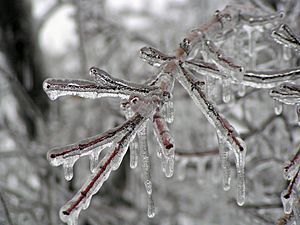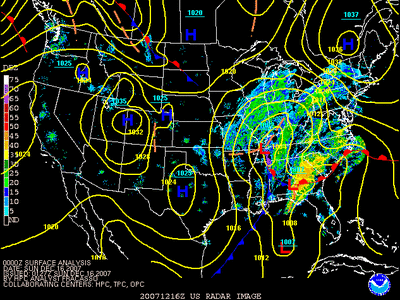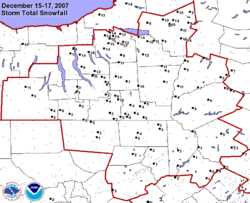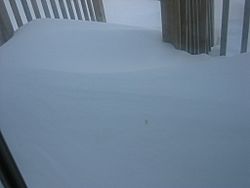Mid-December 2007 North American winter storms facts for kids

Ice on a tree in Kansas City
|
|
| Type | Ice storms Winter storms Tornado outbreak |
|---|---|
| Formed | December 8, 2007 |
| Dissipated | December 18, 2007 |
| Lowest pressure | 974 millibars (28.8 inHg) |
| Tornadoes confirmed | 8 |
| Max rating1 | EF2 tornado |
| Maximum snowfall or ice accretion | 24 inches (61 cm) of snow (Northern Park City, Utah), 1.5 inches (3.8 cm) of ice (Pittsburg, Kansas) |
| Damage | Not yet known, $3.16 million in tornado outbreak |
| Power outages | >1.68 million |
| Total fatalities | at least 64, including 38 from ice storm and 1 from tornadoes |
| Areas affected | Central and Eastern North America |
| 1Most severe tornado damage; see Fujita scale | |
The Mid-December 2007 North American winter storms were a group of two big winter storms. They hit much of central and eastern North America from December 8 to December 18, 2007. These storms brought freezing rain, thunderstorms, sleet, snow, strong winds, and even blizzard-like weather.
The first storms caused a lot of ice in the Midwestern United States and Great Plains. This happened from December 8 to December 11. About 1.5 million homes and businesses lost power. The second storm moved northeast, bringing heavy snow to New York and New England. A third storm caused a huge winter storm from Kansas to Canada's Maritimes. It brought record snow to Ontario, an ice storm to the Appalachians, and tornadoes to the Southeastern United States.
These storms were very serious. At least 22 people died because of the ice storms. Another 25 people died from the snowstorm that hit the Midwest and East on December 15–16. One person also died from the tornadoes in the Southeast.
Contents
How the Storms Formed
Many of the areas hit by these storms had already seen a big winter storm in early December 2007. That storm brought a lot of ice from Nebraska to Illinois. It caused thousands of power outages and at least 16 deaths.
After that first storm, very cold air moved into the Midwest. The first new storm started in the Southwest on December 8. It caused light freezing rain across the Midwest and southern Ontario on December 9. A second, stronger storm formed in the Southwest on December 10. It brought a lot of snow to high places in Arizona and Colorado.
| Total | Location |
|---|---|
| 1.50 in (3.8 cm) | Pittsburg, Kansas |
| 1.50 in (3.8 cm) | Joplin, Missouri |
| 1.25 in (3.2 cm) | Vinita, Oklahoma |
| 1.00 in (2.5 cm) | Ottumwa, Iowa |
| 0.75 in (1.9 cm) | Danbury, Nebraska |
| 0.50 in (1.3 cm) | Spearman, Texas |
| 0.50 in (1.3 cm) | Rensselaer, Indiana |
| 0.30 in (0.8 cm) | Niskayuna, New York |
| 0.25 in (0.6 cm) | Sparta, Illinois |
| 0.25 in (0.6 cm) | Montpelier, Ohio |
| All totals are freezing rain only | |
These storms then caused a wide area of ice across the Central Plains. Together, they brought between half an inch and an inch of ice from Oklahoma to Wisconsin. Mountains in Utah got 8 to 24 inches of snow. Colorado and New Mexico saw 6 to 12 inches of snow. Some areas from Nebraska to Quebec got less than 6 inches, but the Saguenay region of Quebec received 10 inches.
The storm system that caused the ice later moved east. It brought snow and rain to parts of the Northeast and Middle Atlantic States on December 13. Southern and central New York and central New England got the most snow. Some areas in Massachusetts, Connecticut, and New York received up to 12 inches of snow. Boston got 7 inches.
Another major winter storm started on December 14, east of the Rockies. It moved across many of the same areas, bringing heavy snow to places that had already been hit by ice. Parts of Kansas received over a foot (30 cm) of snow on top of the ice. This storm moved across the Great Lakes region on December 15 and 16. It grew stronger by picking up moisture from the coast and from what was left of Tropical Storm Olga.
Many areas in the Midwest and eastern North America received about a foot of snow. This included Chicago, parts of Toronto and Detroit, Montreal, and Ottawa. Northern New England, northern New York, and eastern Ontario got as much as 20 inches of snow. Even "thundersnow" (snow with thunder and lightning) was reported in southern Ontario and Quebec.
Between 8 and 14 inches of snow fell across Ontario, Quebec, most of New England, and the Canadian Maritimes. Kansas and Missouri also saw these amounts. Higher areas in Maryland and Virginia got half an inch to an inch of ice. Significant ice also fell over West Virginia and Pennsylvania.
Heavy rain (2 to 4 inches) fell south of the Mason–Dixon line towards the Carolinas and the Southeast. There was also a lot of rain along the Middle Atlantic Coast, coastal Nova Scotia, and the Avalon Peninsula of Newfoundland and Labrador. Strong thunderstorms also formed in the Southern states near the Gulf of Mexico coast. Several tornadoes were confirmed in these areas on December 15. The storm finally moved out into the Atlantic Ocean on December 18.
These storms were similar to ones in January 2007, which also caused many deaths. They were also like the big Ice Storm of 1998, but not as severe.
Midwest Ice Storm (December 8-11)
Deaths and Power Outages
At least 38 people died in this storm. Most of these deaths were from car accidents on icy roads. Two people died from a falling tree branch and from being too cold.
Nearly 1.5 million customers lost power in total. This was the biggest power outage in Oklahoma's history. More than 600,000 homes and businesses there lost power. This was about 40% of the state's population. Another 350,000 customers lost power in other states like Missouri, Iowa, and Kansas. It took many days to get power back for everyone.
The city of Jones, Oklahoma had no electricity for its water system. Its high school was badly damaged by a fire. The FEMA sent generators and bottled water to Oklahoma.
Emergency Declarations
| City | Snowfall Amounts |
|---|---|
| Northern Park City, UT | 24 in (61 cm) |
| Pagosa Springs, CO | 11 in (27 cm) |
| Los Alamos, NM | 7–11 in (17–27 cm) |
| Washburn, ME | 10 in (25 cm) |
| Saguenay, QC | 10 in (25 cm) |
| Boulder, CO | 6–8 in (10–20 cm) |
| Cozad, NE | 6 in (15 cm) |
| Ottawa, ON | 5 in (12 cm) |
| All amounts are snowfall only | |
Kansas Governor Kathleen Sebelius declared a statewide state of emergency before the storm. President George W. Bush also declared an emergency for Oklahoma. The mayor of Norman, Oklahoma declared her city a disaster area. Oklahoma Governor Brad Henry visited the hardest-hit areas. Damage to power equipment alone was over $30 million in some counties. Missouri's Governor Matt Blunt also declared a state of emergency for parts of his state.
Travel and School Closures
The storm caused problems for people running for president in the 2008 US presidential election. Their planes and events were canceled.
Many flights were canceled at major airports. Chicago O'Hare canceled 560 flights. Tulsa International Airport and Kansas City International Airport also had many grounded flights. Schools from Oklahoma to upstate New York had to close because of the ice.
Northeast Storm (December 13)
| City | Snowfall Amounts |
|---|---|
| Bloomingburg, NY | 10.9 in (26 cm) |
| Boston, MA | 10.5 in (26 cm) |
| Penn Yan, NY | 10 in (25 cm) |
| Binghamton, NY | 9.5 in (24 cm) |
| Waterbury, CT | 8.4 in (21 cm) |
| Montrose, PA | 8.3 cm (21 cm) |
| Emporium, PA | 8 in (20 cm) |
| Goshen, NY | 7.3 in (19 cm) |
| All amounts are snowfall only | |
As the storm moved northeast, many flights were delayed or canceled. Newark International Airport canceled 200 flights, and Boston Logan International Airport canceled 450. Many car accidents happened on highways in Connecticut. In Monroe County, New York, emergency services received 1,800 calls for crashes. No serious injuries were reported. There were no deaths in the Northeast from this storm.
Schools and government offices from Massachusetts to New Jersey and Pennsylvania closed early or for the whole day. Some students in Boston were stuck at school for hours.
December 15–16 Storm
Travel Problems and Flight Cancellations
| City | Snowfall Amounts | |
|---|---|---|
| Ottawa, ON | 33–50 cm (13–20 in) region 37 cm (15 in) Ottawa airport 33 cm (13 in) Gatineau airport |
|
| Quebec, QC | 30–40 cm (12–16 in) | |
| Burlington, VT | 12–16 in (30–41 cm) | |
| Syracuse, NY | 12–14 in (30–36 cm) | |
| Montreal, QC | 30 cm (12 in) | |
| Toronto, ON | 18–35 cm (7.1–13.8 in) region 20 cm (8 in) Toronto airport 33 cm (13 in) Downtown Toronto |
|
| Chicago, IL | 2–12 in (5.1–30.5 cm) region 3 inches (7.6 cm) O'Hare Airport |
|
| Detroit, MI – Windsor, ON | 9 inches (23 cm) | |
| Moncton, NB | 23 cm (9.1 in) | |
| Boston, MA | 8 inches (20 cm) | |
| St. Louis, MO | 6–8 in (15–20 cm) | |
| All amounts are snowfall only | ||
Heavy snow, up to one foot, made it hard to fix things in Kansas. Tens of thousands of people there were still without power. In Chicago, more snow than expected, plus fog and wind, caused 200 more flight cancellations. Many flights were also canceled in Buffalo, Toronto, Ottawa, Quebec City, Montreal, Boston, and Portland, Maine.
A U.S. Airways plane with 31 passengers slid off a runway in Rhode Island. No one was hurt. At Cleveland-Hopkins International Airport, a football team's plane got stuck on a runway because of snow. The team had to take a bus back to Buffalo.
Snow Records
In Ottawa, 37 centimeters of snow fell on December 16. This broke a December record for 24-hour snowfall. It also brought the season's total snowfall to 5 feet in just over three weeks. This was the same amount as the entire winter of 2006–07. Ottawa ended up breaking a new all-time December snowfall record.
In Toronto, 26 centimeters of snow fell. This was close to the 24-hour record set in 1944. In Boston, the snow from this storm and the December 14 storm was more than the total snowfall for all of 2006–07.
Damage and Power Outages
In Brighton, Massachusetts, heavy snow and rain caused a pharmacy roof to collapse. Only minor injuries were reported. Several areas in New York, Michigan, and Indiana declared snow emergencies.
Heavy ice in the Poconos and Pennsylvania caused two television towers to fall. This cut off TV signals for several stations. Strong winds (over 40 mph) also damaged roofs, power lines, and trees in Pennsylvania, Massachusetts, and Rhode Island. Winds over 100 km/h hit Eastern Canada, especially in Cape Breton and Newfoundland. One gust reached 181 km/h.
In Matane, Quebec, strong winds caused storm surge waves that flooded over 10 homes. Over 160,000 customers in Pennsylvania lost power due to ice. 20,000 in the Canadian Maritimes lost power due to strong winds. Other power outages happened in Illinois, Vermont, Ontario, and Quebec.
Road Travel Impact
Hundreds of car accidents were reported in Ontario, Quebec, and several US states. This included a pile-up of seven large trucks on Highway 401 near Cornwall, Ontario. Another pile-up on Highway 401 near Kingston, Ontario caused a truck to leak over 300 liters of fuel. Another truck overturned on Autoroute 40 west of Montreal, spilling kerosene. Several highways in Quebec were closed due to heavy and blowing snow.
Cancellations
The storm caused many events and concerts to be postponed. This included church services and graduation ceremonies at the University of Connecticut and University of Michigan. The Canadian Broadcasting Corporation also postponed a concert. Many schools in the Northeastern United States, Quebec, Ontario, and the Maritimes were closed.
Sports Impact
The storm also affected professional sports. National Football League games in Foxborough, Cleveland, and Pittsburgh were played in tough conditions with snow, sleet, and strong winds. At Giants Stadium in East Rutherford, New Jersey, strong winds caused a fabric dome to collapse, but no one was hurt. In a National Basketball Association game in Toronto, the game was delayed because of a roof leak during the snowstorm.
Deaths from Snowstorm
The snowstorm caused at least 25 deaths across six states and three Canadian provinces. Most deaths were from car accidents. Some people also died from heart attacks while shoveling snow or from being buried by snow.
Southeastern Tornadoes
This same storm system also caused a small group of tornadoes in the Southeast. These tornadoes were caused by a cold front and moisture from Tropical Storm Olga. Eight tornadoes were confirmed. The strongest one was an EF2 tornado in the Lothair, Georgia area. Another tornado in Georgia caused the death of a truck driver on Interstate 75. Strong winds overturned his truck. Significant damage was reported in several areas, including the Pasco County Jail in Florida.
Confirmed Tornadoes
| EFU | EF0 | EF1 | EF2 | EF3 | EF4 | EF5 | Total |
|---|---|---|---|---|---|---|---|
| 0 | 3 | 4 | 1 | 0 | 0 | 0 | 8 |
December 15 Tornadoes
| List of confirmed tornadoes - Saturday, December 15, 2007 | ||||||
|---|---|---|---|---|---|---|
| EF# | Location | County | Coord. | Time (UTC) | Path length | Damage |
| Georgia | ||||||
| EF0 | W of Blakely | Early | 31°23′N 85°02′W / 31.38°N 85.03°W | 2255 | 3.83 miles (6.2 km) | Tornado destroyed an old shed and damaged a mobile home. |
| EF0 | WNW of Sylvester | Worth | 31°33′N 83°55′W / 31.55°N 83.91°W | 0203 | 3.9 miles (6.3 km) | Tornado destroyed a warehouse and damaged 29 homes. |
| EF1 | SW of Ashburn | Turner | 31°41′N 83°41′W / 31.69°N 83.68°W | 0220 | 3.5 miles (5.6 km) | 1 Death Tornado destroyed 4 mobile homes and damaged 39 homes. A truck on Interstate 75 was blown off the road, and the driver died. |
| EF1 | W of Owensboro | Wilcox | 31°52′N 83°28′W / 31.87°N 83.46°W | 0230 | 0.5 miles (0.8 km) | Brief touchdown. Tornado tore the roof off an old shed and destroyed a cinder block building. |
| EF0 | ENE of Jay Bird Springs | Dodge | 32°10′N 89°55′W / 32.16°N 89.92°W | 0318 | 0.5 miles (0.8 km) | Brief touchdown. Tornado damaged one mobile home and knocked down many trees and power lines. |
| EF2 | SW of Lothair | Treutlen | 32°20′N 82°40′W / 32.34°N 82.66°W | 0341 | 3.5 miles (5.6 km) | Tornado destroyed a fire department building, a mobile home, and a carport. |
December 16 Tornadoes
| List of confirmed tornadoes - Sunday, December 16, 2007 | ||||||
|---|---|---|---|---|---|---|
| EF# | Location | County | Coord. | Time (UTC) | Path length | Damage |
| Florida | ||||||
| EF1 | SSE of Hague | Alachua | 29°44′N 82°25′W / 29.73°N 82.41°W | 0745 | 0.75 miles (1.2 km) | Brief touchdown. Many pine trees were snapped. A brick wall was knocked over, and a metal roof was ripped off a farm building. A farm truck was flipped. |
| EF1 | NNW of Land o' Lakes | Pasco | 28°19′N 82°31′W / 28.31°N 82.51°W | 1020 | 3.2 miles (5.1 km) | A housing building at the county jail was destroyed. All 125 inmates were moved out before it was destroyed, so no one was hurt. A fire station also had roof damage, four cars were flipped, and many trees and power poles fell. |




